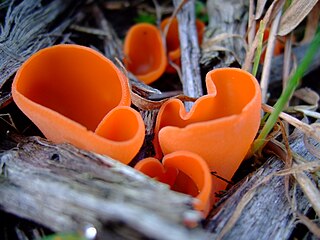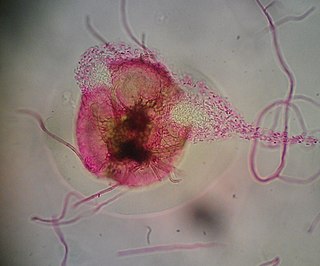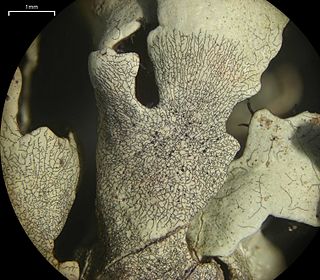
Pezizomycotina make up most of the Ascomycota fungi and include most lichenized fungi too. Pezizomycotina contains the filamentous ascomycetes and is a subdivision of the Ascomycota. It is more or less synonymous with the older taxon Euascomycota. These fungi reproduce by fission rather than budding and this subdivision includes almost all the ascus fungi that have fruiting bodies visible to the naked eye.

Dothideomycetes is the largest and most diverse class of ascomycete fungi. It comprises 11 orders 90 families, 1,300 genera and over 19,000 known species. Traditionally, most of its members were included in the loculoascomycetes, which is not part of the currently accepted classification. This indicates that several traditional morphological features in the class are not unique and DNA sequence comparisons are important to define the class.

Phaeosphaeria nodorum is a major fungal pathogen of wheat, causing the disease Septoria nodorum blotch. It is a member of the Dothideomycetes, a large fungal taxon that includes many important plant pathogens affecting all major crop plant families.

The Pleosporales is the largest order in the fungal class Dothideomycetes. By a 2008 estimate it contains 23 families, 332 genera and more than 4700 species. The majority of species are saprobes on decaying plant material in fresh water, marine, or terrestrial environments, but several species are also associated with living plants as parasites, epiphytes or endophytes. The best studied species cause plant diseases on important agricultural crops e.g. Cochliobolus heterostrophus, causing southern corn leaf blight on maize, Phaeosphaeria nodorum causing glume blotch on wheat and Leptosphaeria maculans causing a stem canker on cabbage crops (Brassica). Some species of Pleosporales occur on animal dung and a small number occur as lichens and rock-inhabiting fungi.

Dothideomycetidae is a subclass of Dothideomycetes consisting of three orders: Dothideales, Myriangiales and Capnodiales. The cavities of the sexual structures do not have vertical cells growing between the sac-like cells bearing the sexual spores (asci).

Capnodiales is a diverse order of Dothideomycetes, initially based on the family Capnodiaceae, also known as sooty mold fungi. Sooty molds grow as epiphytes, forming masses of black cells on plant leaves and are often associated with the honeydew secreted by insects feeding on plant sap. This diverse order has been expanded by the addition of several families formerly thought unrelated and now also includes saprobes, endophytes, plant pathogens, lichens and rock-inhabiting fungi. The new additions include the genus Mycosphaerella containing the causal agents of several economically important crop and tree diseases. A small number of these fungi are also able to parasitise humans and animals, including species able to colonise human hair shafts.

Pleosporomycetidae is a subclass of Dothideomycetes consisting of four orders: Pleosporales, Hysteriales, Mytilinidiales, and Jahnulales. One of its defining features is the presence of pseudoparaphyses. These are sterile cells extending down from the upper portion of the cavity inside sexual structures containing the sac-like asci with sexually produced spores (ascospores). Pseudoparaphyses are initially attached at both their ends, but sometimes the upper part may become free. Some orders and families where these cells are present remain outside the subclass since DNA based phylogenies cannot place them with confidence. However they could conceivably be included within Pleosporomycetidae in future.

The Botryosphaeriales are an order of sac fungi (Ascomycetes), placed under class Dothideomycetes. Some species are parasites, causing leaf spot, plant rot, die-back or cankers, but they can also be saprophytes or endophytes. They occur world-wide on many hosts.

A pycnidium is an asexual fruiting body produced by mitosporic fungi, for instance in the order Sphaeropsidales or order Pleosporales. It is often spherical or inversely pearshaped (obpyriform) and its internal cavity is lined with conidiophores. When ripe, an opening generally appears at the top, through which the pycnidiospores escape.

Arthoniomycetes are a class of ascomycete fungi. It includes two orders: Arthoniales and Lichenostigmatales. Most of the taxa in these orders are tropical and subtropical lichens.

Lophiostoma is a genus of ascomycetous fungi in the family Lophiostomataceae.
Camarosporula is a genus of fungi in the class Dothideomycetes. The relationship of this taxon to other taxa within the class is unknown. This is a monotypic genus, consisting of the single species Camarosporula persooniae. Teleomorph synonyms — Anthracostroma persooniae.
The Hysteriales are an order of fungi in the class Dothideomycetes, subclass Pleosporomycetidae. It consists of a single family, Hysteriaceae. Members of Hysteriales produce elongated, often boat shaped sexual structures with slit-like openings (hysterothecia). However species with these structures are very diverse. Comparisons based on DNA sequences indicate species with hysterothecia do not share a single ancestor and therefore species with hysterothecia can be found in several fungal orders. The newest definition of the order relies on DNA sequence differences and a combination of morphological characters.

The Lichenotheliaceae are a family of fungi, and the only family in the order Lichenotheliales, which is in the class Dothideomycetes. The family contains three genera.
The Aliquandostipitaceae are a family of fungi in the Ascomycota, class Dothideomycetes. The family was described by Patrik Inderbitzin in 2001, and the order Jahnulales was created in 2002 to accommodate the family. The distinguishing characteristic for members of the family are the unusually wide hyphae that support the spore-bearing structures, and the presence of ascomata both with and without stalks. The genus Aliquandostipe has a pantropical distribution, having been found in Central America and southeast Asia; Jahnula has a wider distribution. Species in the family are saprobic, and are typically found growing on rotting wood.
The Myriangiaceae are a family of fungi in the Ascomycota, class Dothideomycetes. Species in this family have a widespread distribution, and are typically found associated with scale insects. The family occupies an isolated phylogenetic position within the Dothideomycetes.
The Jahnulales are an order of fungi in the class Dothideomycetes, subclass Pleosporomycetidae. They are ascomycetes that have stalked/stessile and dimorphic ascomata, hyphal stalk cells that are about 40 μm wide. It contains the families Aliquandostipitaceae, and Manglicolaceae.
Dilophospora is a genus of fungi belonging to the order Dothideomycetes, in the family Sporocadaceae.

Strigulales is an order of lichen-forming fungi in the class Dothideomycetes. It contains two families: Strigulaceae and Tenuitholiascaceae, with a combined total of 115 species. The order was proposed by Robert Lücking, Matthew Nelsen, and Kevin Hyde in 2013. Most species in the order are foliicolous, that is, they grow on plant leaves.

Tenuitholiascus is a fungal genus in the monotypic family Tenuitholiascaceae, itself in the order Strigulales. The genus contains a single species, Tenuitholiascus porinoides, a foliicolous (leaf-dwelling) lichen found in China.













